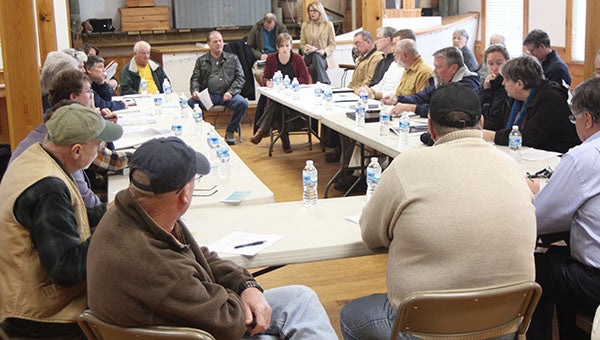Input sought on pollution plan
Published 8:54 pm Saturday, January 31, 2015

Dana Gonzales, from the Virginia Department of Environmental Quality, leads a discussion at C.E.&H. Ruritan Hall in Eclipse on plans to clean up Chuckatuck and Brewers creeks.
Residents, environmentalists, farmers and local government representatives met in Eclipse on Thursday to start hashing out a plan to reduce pollution in Chuckatuck and Brewers creeks.
A 2006 study found high bacteria levels, and the federal Clean Water Act requires development and implemented a pollution-reduction plan.
The aim is to reduce nonpoint source pollution, from things like livestock grazing and other agricultural practices, residential waste, and pet and other animal droppings.
The plan will not target pollution from things like factories and sewage treatment plants, said Dana Gonzalez, the plan coordinator with the Virginia Department of Environmental Quality who led the roundtable at the C.E.&H. Ruritan Hall.
“I’m not coming in here trying to tell people what to do,” Gonzalez said, stressing the importance of having the folks it will affect help develop the plan, which will be implemented voluntarily.
During the meeting, Gonzalez ran through an early inventory of nonpoint pollution sources the plan would seek to reduce, asking folks for their input. It was a rough inventory that would need refining, she said.
Most input was on the wildlife numbers, which included 446 deer, 34 ducks, 375 geese, 1,044 raccoon and 414 muskrats. The livestock tally included 1,350 pigs, although two farmers around the table said there are no hog farms in the watershed.
Gonzales also presented early data on residential waste disposal: 849 houses on septic systems, and, applying an accepted estimate of 12 percent, 102 of those failing.
Stewart Lassiter, the city of Suffolk’s utility engineering manager, said those figures were wrong and he would get Gonzales the correct information. The second and final phase of a petitioned project to connect communities to water and sewer mains will take another 177 septic tanks offline in Crittenden and Eclipse early this summer, he said.
According to Gonzales, making the plan as detailed as possible now will make it easier to tap into funding sources later for implementation. “The purpose is to come up with a plan everybody can buy into, then come up with a plan to go get funding,” she said.
Nansemond River Preservation Alliance member Geoff Payne asked the gathering of two dozen or so whether they’d be willing to make the effort to put the voluntary plan into action. “It does require the people sitting around this table to take the results and do something with it,” he said.
Farmer Joe Barlow said, “The agriculture community wouldn’t be in business today if it wasn’t interested in the environment. We will do everything we can to preserve the watershed.”






